






"If you want to go fast, go alone. If you want to go far, go together.”
The Montana State Golf Association has been making progress in a lot of areas over the past couple seasons. You may have noticed some of the changes in our digital magazine, expanded tournament offerings and educational online seminars.
Our team has expanded and in everything we do, we work together. Thanks to support of our board of directors, a new strategic plan and you, our members, we are continually looking to deliver more value for your membership.
Partnerships have played a critical role in the development of the MSGA’s programming in recent years. So, who are our partners?
The USGA, golf’s governing organization in the United States has long provided us with exemplary support through the rules of golf, handicap administration and course rating guidance. Last year Montana benefited from expanded exemptions to USGA Championships, and we are anticipating more opportunities in the coming years. Furthermore, the P.J. Boatwright Jr. Internship has provided a training ground for our team’s development. Currently, ½ of our staff are former Boatwright Alumni and we are so thankful to the USGA for their increased and continued support of this program nationwide.
The PNGA, the Pacific Northwest Golf Association welcomed Montana in 2023, and our players benefit from competitive oppor-

tunities at the regional level and every member has access to Pacific Northwest Golfer Magazine as a member benefit.
The IAGA, the International Association of Golf Administrators provides a great educational and networking source for golf associations internationally. Annually, we attend a regional and national conference to learn best practices, share news and updates and learn from one another as we work towards many of the same goals for golfers everywhere.
The Pacific Coast Golf Association is a new partner organization that will allow select, high-level amateurs to compete against many of the nation’s top amateurs and new for 2025, Montana will field a team in addition to our annual junior teams at the Junior Americas Cups (Boys and Girls) and the Montana-Alberta Junior Ryder Cup.
Continually, the two local PGA Chapters

(Western Montana and Yellowstone) our local Golf Course Superintendents Association of America Chapter (Peaks and Prairies) are trusted allies in moving the game forward from the turn to the practice tee and beyond.
In our next issue we will be announcing junior grant recipients and scholarship award winners for 2025. To be able to deliver on our goals and programs, the MSGA has sought out philanthropic and corporate partners.
We are excited to announce that this year, our first Official Corporate Partner is Opportunity Bank of Montana. Opportunity Bank serves the entire state, just like the MSGA. Our values are aligned and our ethic
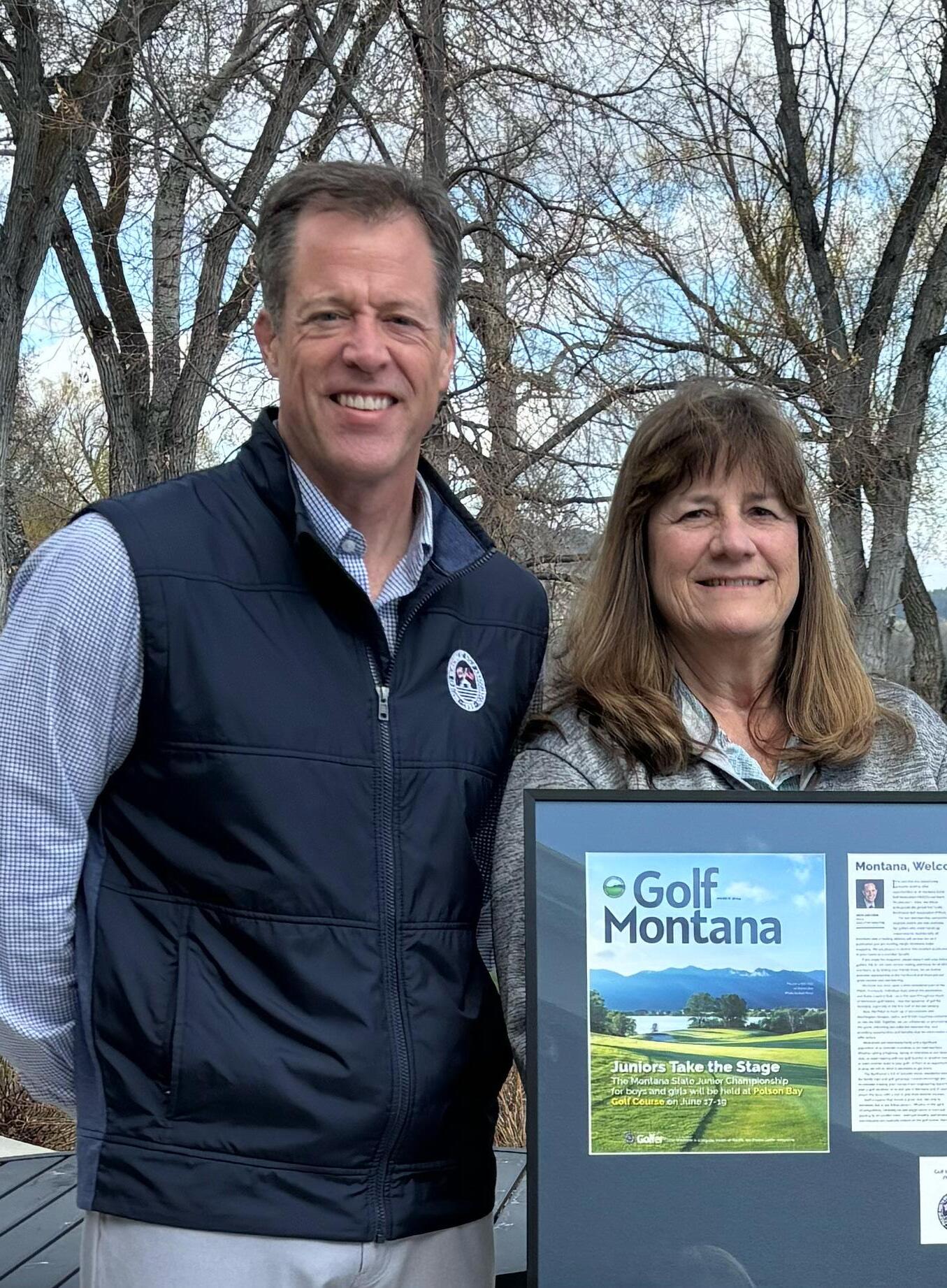
of serving Montanans will continue to drive our engagement and ability to expand our philanthropic work, together. As the season progresses, we will be highlighting our partners, their work and our joint efforts in strengthening Montana Golf. We thank our new, continued and future partners for their commitment to serving and connecting the Montana Golf Community.
Together, we can go far. Together, we are Montana Golf!




BOARD OF DIRECTORS - OFFICERS
PRESIDENT................................................... Peter Benson
VICE PRESIDENT.................................. Ron Ramsbacher
TREASURER....................................................... Bill Dunn
PAST PRESIDENT......................................... Mary Bryson
EXEC COMMITTEE......................................... Karen Rice
BOARD OF DIRECTORS
Brett Bennyhoff, Peter Benson, Carla Berg, Mary Bryson, Bill Dunn, Cheri Ellis, Lisa Forsberg, Marcia Hafner, Ron Ramsbacher, Karen Rice, Joe Rossman, Rod Stirling
MSGA STAFF
Executive Director......................................... Nick Dietzen
Tournament Director...................................... Tim Bakker
Membership Operations Director............... Emily Hulsey
Member Services Coordinator......................... Ian Hulsey
Communications & Tournament Manager.... Katie Fagg
Communcations Coordinator.......................... Ty Sparing
Partnerships & Business Development.......... Jess Miller
USGA PJ Boatwright, Jr. Intern................. Jaideep Desai
USGA PJ Boatwright, Jr. Intern................ Dean Hendrix
USGA PJ Boatwright, Jr. Intern...................... Ella Prigge
Jess Miller.................................. 1 (800) 628-3752, ext. 5
406GOLF STAFF
Editor in Chief............................................... Nick Dietzen
Consulting Editor........................................ David Bataller
Senior Writer..................................................... Ty Sparing
Graphic Designer............................................... Katie Fagg

Montana State Golf Association P.O. Box 4306
Helena, MT 59604
1 (800) 628-3752
www.msgagolf.org






BY TY SPARING MSGA Communications Coordinator
Golf in the Kalispell area goes back over one hundred years to 1918 when the short-lived Somers Country Club opened just south of the city. Just a couple years later the Kalispell Country Club, (aka the Buffalo Hill Golf Club) was conceived and by the spring of 1921, a nine-hole course near Lawrence Park was laid out. A Spokane “golf expert” named Walter Gorringe came over to help design the original layout.
Located on land once home to the famous privately owned Conrad Buffalo herd, the aptly named Buffalo Hill Golf Club was an immedi-

ately popular nine-hole destination throughout the 1920s. However, like many other courses of the era, a major economic downturn at the close of the decade altered plans for the future. The course continued to operate privately until 1935 when the proprietors of the Buffalo Hill Golf Club transferred ownership to the city of Kalispell. It was a savvy move for the sake of golf in Kalispell, as once the course became city owned it made them “eligible for the expenditure of $13,000 or more in federal funds.”
In a somewhat ironic twist of fate, it was the Great Depression that instigated Buffalo Hill’s first great transformation. The course where buffalo once roamed received significant funding from the Works Progress Administration


1930's.

(WPA) which was part of the broader New Deal initiatives of Franklin D. Roosevelt. Along with improvements to the original nine-hole course, the city of Kalispell acquired more land to be used for another nine-holes (which are now known as the Cameron 9 after former course manager, Dave Cameron) and a modern clubhouse. By the time the New Deal was phased out in the early 1940s, the WPA had built sixteen golf courses and improved 23 others all over the state of Montana. Perhaps no course benefited as much as Buffalo Hill who received nearly $100,000 (worth roughly $2 million today) in the form of labor and resources.
With a modern clubhouse and one of the
finest 18-hole courses in the Pacific Northwest, the Buffalo Hill Golf Course (aka Kalispell Municipal Golf Course) was on its way to becoming one of the most popular golfing destinations in Montana.
1963 marked another era of transformation as a new nine holes were constructed over the original nine carved out decades before, along with a modern storage shed used to house golf carts. Bill Peterson guided the project and with the invaluable help from dozens of volunteers, the Buffalo Hill Golf Course was redefined once again. Among others helping with the construction was MSGA Hall of Famer C.C. “Pop” Vaughn who “ran the sod crew which

built all the tees.” Vaughn, along with fellow MSGA Hall of Famer George Sarsfield, organized the State Seniors Association in 1956 and served on its original board of directors.
Just a decade and a half later Buffalo Hill went through yet more dramatic changes with the opening of the brand new, Robert Muir Graves designed Championship 18 course. Leaving the original front nine alone, Graves incorporated six holes on the former back nine with twelve entirely new holes constructed near the Stillwater River, giving Buffalo Hill Golf Club a whopping 27 holes total.
To honor the occasion, Arnold Palmer showed up for an exhibition match on the day of the grand opening of the Championship 18. At the time, Montana was the only state within the continental U.S. that Palmer had not appeared in either a tournament or exhibition match, and it was fitting that what would become one of Montana’s most played courses would draw a legend like Palmer to the Treasure State. We might say in typical Montana fashion that Buffalo Hill was the last best place on Palmer’s tour around the U.S.
(By the way, Palmer had a tough time sinking birdie putts on his way to a 1-over par 73.)
Things certainly haven’t slowed down around the Buffalo Hill Golf Club these days, as it remains one our state’s most played courses with roughly 10,000 total rounds played in 2024. Not only is it an incredibly popular golfing destination for both locals and tourists alike, Buffalo Hill also acts as one of Montana’s premier tournament locations, having hosted a variety of MSGA and high school events over the years, along with its popular 4th of July tournament that draws some of the best talent in the region.
Over a century old and still going strong, the Buffalo Hill Golf Club is truly one of Montana’s signature courses. If it’s been a while or you have never played there, start planning your trip today!

BY STELLA CLARIDGE
Buffalo Hill is one of the most unique golf courses in Montana. Although I have played it hundreds of times over the last 15 years, it never seems to get old, always offering up a challenge and setting up a very competitive environment.
Put away your driver! Most times at Buffalo Hill you don’t need it unless you’re playing in a scramble. It’s a tight course with a lot of trouble, so it is best to hit a long iron or wood off the tee. If you are playing in a tournament, it would also be smart to play a practice round as there are a lot of blind shots. Hole 17 for example, is a par 4 that is uphill, then drops off

about 135 yards to the green, so you cannot see anything besides the hill in front of you from the tee box. Without playing it before, you would have no idea where to aim or what club to hit. It is not a course you can play risky on until you know it super well. Course awareness is the biggest advantage when I am competing against those who have never played it.
Buffalo Hill has some super cool and challenging holes. The most challenging hole is the second, especially from the back tees, because it is extremely long uphill, then downhill, and a dogleg right. If you do not hit the ball far with accuracy, you’ll want to play it safe as a bogey hole.
I would say the majority of people enjoy hole 12 the most. It is a short downhill par 3 –

only about 80 yards – that everyone attempts to get a hole in one on (many succeed at some point). During tournaments, the KP is usually within a couple of inches.
Beautiful scenery is abundant at Buffalo Hill, with tree lined fairways, the Stillwater River winding through the area and of course the majestic mountain views in the distance. Hole 18 in particular is a scenic par 4, overlooking the south end of Kalispell and Lawrence Park.
The greens at Buffalo meanwhile are hard to read as they are all very slopey and different from each other.
Along with the “Champion 18” Buffalo Hill also has the “Cameron 9” which is the perfect course for learning how to play golf, as it is short and straightforward. I learned how to swing a club on the Cameron 9 when I was

about four years old, and then I was on the Buffalo Hill Junior PGA team after that. One of my fondest memories growing up was going to the week-long golf camp they held every year, just one example of how they truly cater to the future of golf through youth clinics, camps, state tournaments, and the super fun and engaging Flathead Valley youth tour tournaments that Jeff Sherrill organizes. No course compares to Buffalo when it comes to getting younger generations involved.
The Cameron 9 is usually super busy, so I recommend going in the morning or evening to beat the crowd. The Cameron helps to keep the Championship 18 following the pace of play since more experienced golfers tend to play that side instead of the Cameron. The derby’s are always held on the Cameron which is fun as well because it provides a lot of entertainment and is right next to the clubhouse.


Along with the outstanding courses, Buffalo Hill also has one of the most fun facilities around, with a restaurant and patio bar right next to the range and a green practice area. The food is fantastic (I may be biased because I worked there for 2 years). What makes it even more special is the service you get. Every worker establishes valuable connections with the members and community. It has a substantial membership, yet everyone seems to know each other. I could go on and on about all the special aspects of the club, but I’ll end it at that.
The rates and prices are very reasonable and are decided on by the membership for the most part. They also host events at the

restaurant; my family goes there every year for Easter brunch and occasionally Mother’s Day. I also had my Graduation party there and it was terrific. The whole environment at Buffalo keeps me wanting to play golf. It is so much fun, but also never fails to keep me humble.
Buffalo has become an integral part of many Kalispell golfers’ lives. The same crowd is there every day, working on their game. It is truly a piece of me and many others and I hope everyone has the chance to play it at some point. If I hadn’t grown up with the support of the Buffalo Hill community I don’t think I would be a collegiate golfer or be where I am today.



BY EMILY HULSEY
MSGA MEMBERSHIP DIRECTOR
I just started playing and I’m not sure what a Handicap Index is.
A Handicap Index® is a portable number that measures your ability when playing well. It’s converted into a Course Handicap™ for the course and tees you play, which is simple to do in the GHIN® app! You can also use the USGA’s Calculator. Your Course Handicap changes from tee to tee and is used to determine your “target score”, to find which tees are the best suited for your ability. The maximum Handicap Index is 54.0, so no matter what your skill level, all players should have one, even if you don’t compete.
Your target score is your Course Handicap + the total par of the tees you’re playing. For example, if your Course Handicap is 20, and the total par is 70, your target score is 90. Players might shoot their target score about 15-20 percent of the time and can expect to shoot 2-4 strokes higher in most rounds.
I’m not a member of a club, so how do I get a Handicap Index?
You don’t have to be a member of a private club or a “green grass facility” to get a Handicap Index. Anyone can sign up at msgagolf. org/join-the-msga or usga.org/getahandicap. You’ll then have access to the GHIN® app or ghin.com, where you can post scores and manage your record.
But, sometimes I pick up my ball and move to the next hole.
That’s okay! Having a Handicap Index can actually help improve pace of play! Before your Handicap Index is established, the maximum hole score is par + 5, so you can pick up once you’ve reached that number (for example, if it’s a par 3, pick up once you’ve hit 8). Once you have a Handicap Index, the maximum hole score is net double bogey (par + 2 + any handicap strokes you receive on the hole). If you don’t want to do the math, post your round hole by hole in GHIN as you play and it calculates for you! In casual rounds, you can pick up whenever you reach that number and still post your score!
I’m not good enough to have one.
It doesn’t matter how often you play, your ability, or how competitive you are, if at all. Having a Handicap Index benefits all golfers! You can use a Handicap Index to:
1. Track your individual progress, including stats, and set goals for your game.
2. Have a more accurate evaluation of your performance in each round. For example, a 95 on a difficult course may be more impressive than a 92 on an easier one – and having a Handicap Index will show that.
3. Set a target score before your round to help you choose the right tees to play from. When you shoot your target score, you know you’ve had a great day!
4. Have a fun and fair game with your friends and family.






1. Who introduced you to golf?
As a kid growing up on a ranch in Idaho in the ’60s and ’70s, golf was never even a thought for our family. It wasn’t a High School sport. I was a Basketball and Baseball kid and Basketball was eventually the reason I took up golf in my mid-20s. My knees and ankles were so bad from injuries but my competitiveness never wavered. Through work, I was introduced to golf at district and corporate meetings.
One of the first courses I was able to play was the course at Park City Utah, Jeremy Ranch. I could not believe how bad I played, but how great it was to be on a beautiful course with my work buddies. Back in Idaho I started playing in Idaho Falls at Sand Creek and Pinecrest Golf Courses. Soon I became better and better and was hooked on the game. Now as a Right Above The Knee Amputee I play even better, because I have to really commit to my swing on each and every hole.
2. Who influenced you most in your golf life?
As with most guys my age, TV was where we really learned about golf, and the

players who have inspired us to play and keep playing. My guy was Johnny Miller, probably because he had to play with a chip on his shoulder to compete against the other greats like Palmer and Nicklaus. I also loved to watch Fred Couples.
Now it's always Spieth and Finau. But because of the adversities that Tiger has had to overcome, it really inspires me as a recent Amputee of three years to do my best.
3. What’s the best part of your golf game?
My two most favorite clubs in the bag are my 3 wood and my putter. I feel that I am very good at my long approaches and putting once on the green.
4. What is your favorite course in Montana and why?
I want to make many of you jealous right now when I say a private course that I am not a member of, but do get my share of rounds on it. That course is Iron Horse in Whitefish. I really love to play this course as my son “Golf Professional Steven Williams” is the Assistant Golf Pro



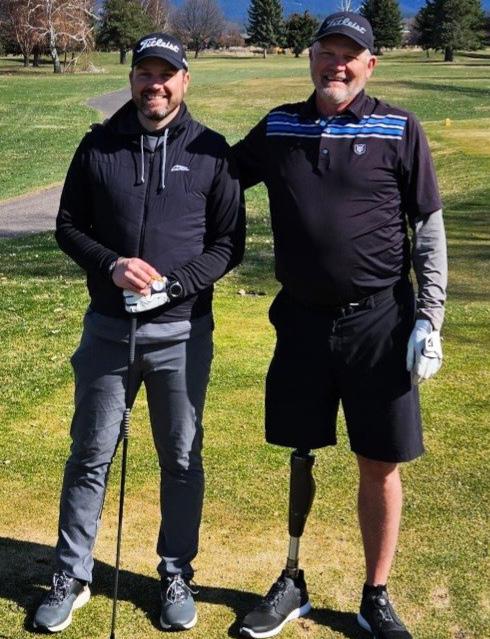

at this beautiful place to play. Steven is so busy during the summer with work, that we rarely get together to play other than a few Pro Ams. But when we play Iron Horse we are always playing together and I really enjoy those days.
5. What is a dream golf course you’d like to play once?
Pebble Beach would be a dream come true. I just love the scenery and the holes we have all fallen in love with on TV.
6. What is your dream celebrity foursome (living or dead)? Why would you choose them?
Hopefully it's a fivesome so that I can play with them. The conversations back and forth would be so cool to be part of. Jack Nicklaus, Tiger woods, Jordan Spieth, Tony Finau. This is such a great group and can you imagine the respect they would have for each other and the strengths they possess.
7. What’s your most memorable moment on a golf course?
Early in my golfing days I was able to play in a charity Pro-am with Utah Jazz Center Mark Eaton. And for my memorable moment as a player, I won a flight at the Whitefish Lake Golf Courses 54 hole “Earl Hunt Memorial Fourth of July Tournament”.
8. If you could change one thing about the game of golf what would it be?
That each and every course would learn to understand the need to prepare for golfers with disabilities.
You would be shocked by the courses
that I have played in Montana that do not even have blue flags and do not even have a policy for what that flag means or allows a golfer to do with it. I have been berated over eight times in my three years of golfing with a flag. Mostly it's someone from another hole who chooses to come clear to my hole to tell me that we do not allow golfers to drive up on tee boxes or next to greens. I have also been reported to many pro shops that a guy is breaking the rules. Then some poor ranger comes driving up to me and then sees me and is embarrassed.
9. What advice would you give to beginner golfers?
#1 Find a good player who is patient and willing to golf a few rounds with you. Listen and learn good golf etiquette. I have helped others by letting them know up front on the first tee that it is OK to play a scramble with my ball at any time in the round to make them more comfortable and keep the group moving.
#2 get to a Par 3 and hit your drives, then let the faster group behind come up and hit while you wait. Then everyone move up and let the fast group putt out and move forward. Everyone will be happy and the pace of play increases.
Bonus: Lay up or go for it?
Before my amputation lay up, after my amp I need to go for everything that I can.





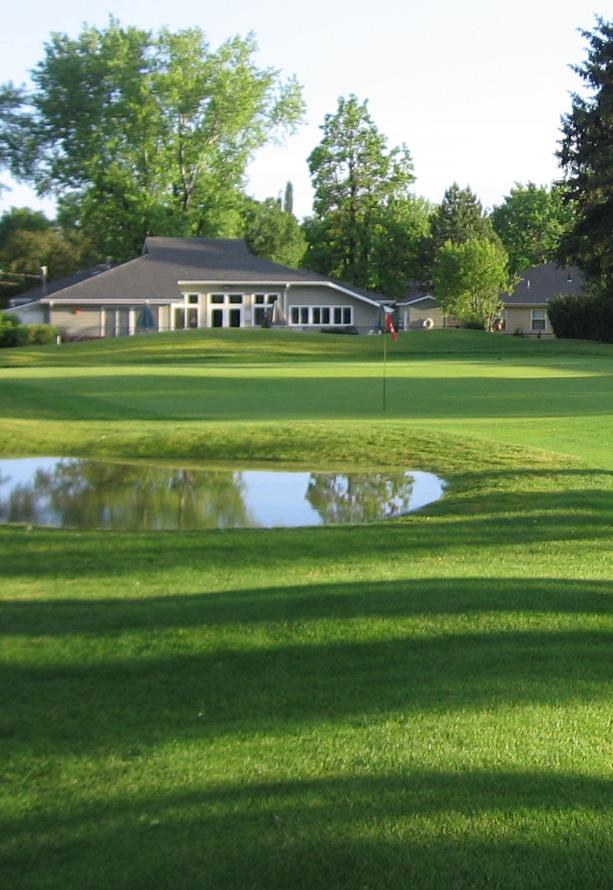
BY PETE GRASS CERTIFIED GOLF COURSE SUPERINTENDENT
Since I will be writing a monthly article for this newsletter, as I am starting this month’s edition, I realized I failed to properly introduce myself in my first submission “The Augusta Syndrome” last month.
I am just a few months into my full retirement after working just 4 months shy of 50 years at Hilands Golf Club, a now 102-yearold, 9-hole facility located smack dab in the center of Billings. In 1975 as a high school sophomore, I started as a Pro Shop “Bag Boy” for 2 seasons, moved to the Grounds staff in 1977, became Assistant Superintendent in 1981 and Superintendent in 1991. During that time, I am proud to have served many years in leadership of both the GCSAA (Golf Course Superintendents Association of America) a 20,000-member group from 80 countries and Peaks & Prairies GCSA (our regional, primarily MT/WY Chapter) of GCSAA.
Ok, on to the topic of the month, Golf and Mental Health. It was unfortunately very late in my career, 2020 that I was “formally” introduced to understanding mental health treatment. Like everyone I believe, I had “normal” ups and downs, along with my family, co-workers, friends, etc.., we all experience these, most times daily. My “breakdown” as I call it, came on a late June afternoon when a combination of factors, both personal traits and work/
weather related stresses put me in a condition I had never felt before, totally overwhelmed and not knowing what to do about it. I was then and still am blessed to have 2 “angels” I refer to them as, who I knew and reached out to for help. Kee Dunning, a 40-year therapist and self-diagnosed “golfaholic” and Stacy Stellflug a Nurse Practitioner and Dr. of Nursing Education, work together with people treating both mind and body. I was able to meet with them and they provided both an understanding of the traits/conditions I have (ADD, OCD, Anxiety) and how they affect my thoughts and actions.
They also introduced me to Cognitive Behavioral Therapy, a way of self-analyzing situations and making appropriate responses to them. Since that meeting, I am happy to say my life has become so much better, far from perfect but each day and situation since, with the tools I learned, has been handled so much better than before. I became a better husband, father, boss, co-worker, friend, etc., with the help I was given.
My biggest regret looking back is that I did not ask for help much sooner in my life/career as those traits had been a part of me for most of my life. My mission ever since has been to

encourage others, especially those in the golf industry, to understand and deal with the pressures that mother nature and humans put on them and not let self-inflicted mental health wounds injure them. Kee and Stacy joined me on that journey and for the last 4 years we have been working with Peaks & Prairies GCSA and at the last 3 years GCSAA International Educational Conferences. We have presented two seminars, “Healthy Teams–Healthy Greens” on how communication can improve your personal and professional lives, along with “Mind Matters-Insights from a Therapist, Doctor and Superintendent on Identifying and Treating Mental Health Challenges.” It is extremely rewarding to get feedback from attendees who share their stories and how the information we provided has helped them. This leads me to know how what I have shared so far can mean something to everyone, not just those who work in the golf industry. I think anyone who is honest with themselves has at some point, daily, weekly, monthly, yearly, had struggles within themselves or someone around them. Sometimes they can, yes, be a true mental health diagnosis challenge – but often not, just something that gives them

stress or anxiety. How we react and handle them is such an important part of staying mentally healthy (and physically). Seeking help early on can save someone years of unnecessary struggle which in turn, makes everyone in their lives in a better position also.
Where does/can golf fit into “mental healthiness”? Again, better late than never, I started looking at “golf” where I basically had spent the majority of my life around, as an outlet of stress relief, a getaway from daily pressures, where being in nature brings a certain peace to one’s soul. In the last few years, I have started asking golfers what they enjoy about playing golf. Four common responses come back: I like the challenge to myself, I enjoy the friends I play with, I love the beauty and natural environment of golf courses, and it gives me a place to go and get away from work/home/life stresses and concentrate on something else. It would very much surprise me if you, as someone who plays a little or a lot of golf, would not reply in one if not more or all those categories. Those of us who work in golf do not typically think of what we do as providing mental health therapy, but it now to me is one of the most important aspects of what golf provides its participants.
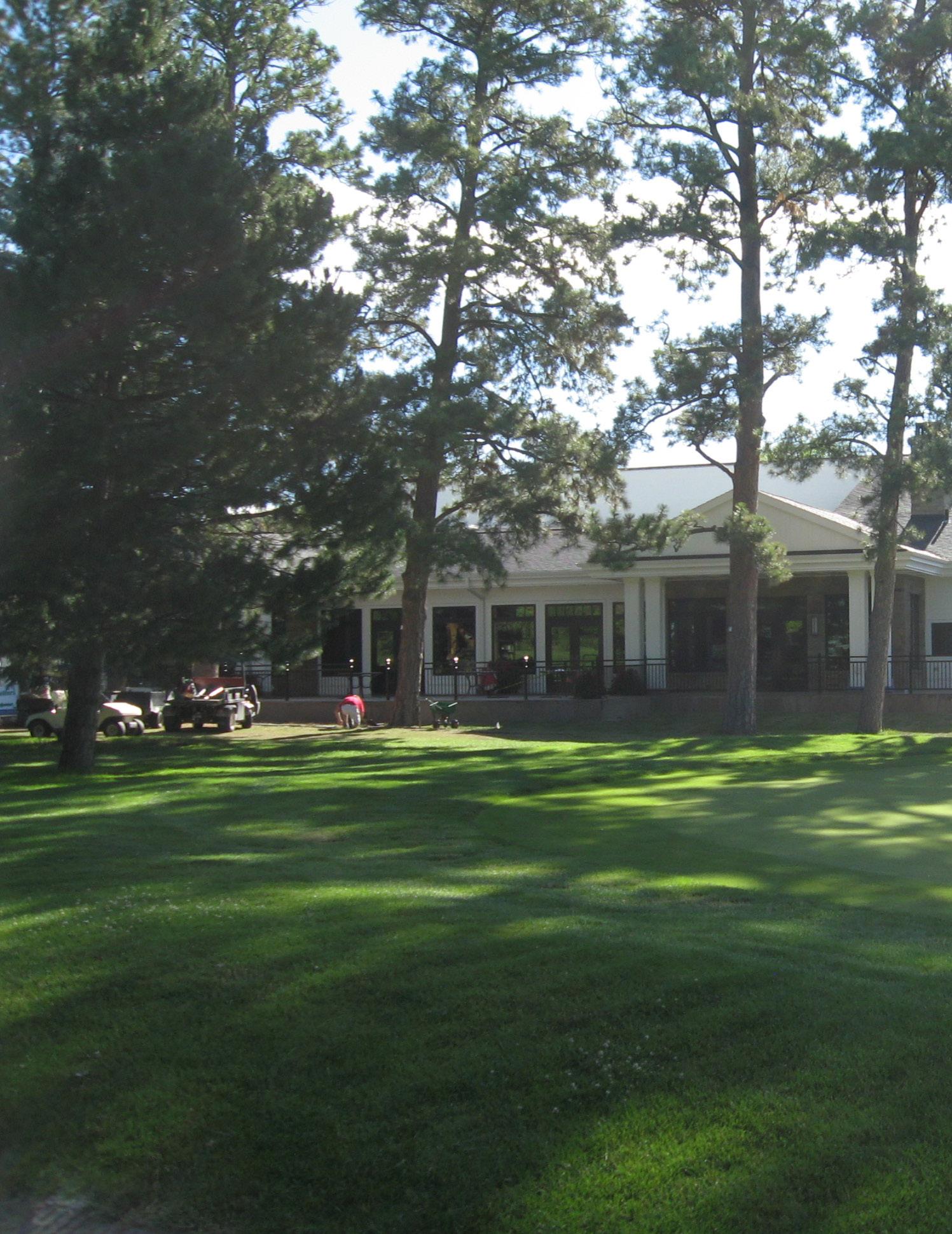
I certainly hope that you are one of the millions who do find joy and relaxation while having a club in your hands. The game can be frustrating yes, but keeping the right frame of mind about what is important in life is the key to not letting that frustration cause anxiety. Breathe fresh air, get some exercise, enjoy the birds, ducks, geese, deer, elk, bears, squirrels or whatever wildlife you encounter, the contrast of trees, turfgrass, sand, sometimes hills, mountains or plains on the artistic canvas that a golf course is. You are “paying good money” to play, don’t use your hard-earned cash to be frustrated, use it to challenge yourself, enjoy friends, nature and leave your outside world behind for a few hours.
Be kind to yourself and others, if not golf, find something that gives you enjoyment and relaxation and most importantly, if you need help, ASK FOR IT!!! You would go to a doctor or dentist for something that hurts you physically, there is truly no difference (or embarrassment) in going to someone who can help with mental pain. Life is too short to not do everything you can to make it as enjoyable as possible. Certainly, as you get older like me now, that really starts to sink in.
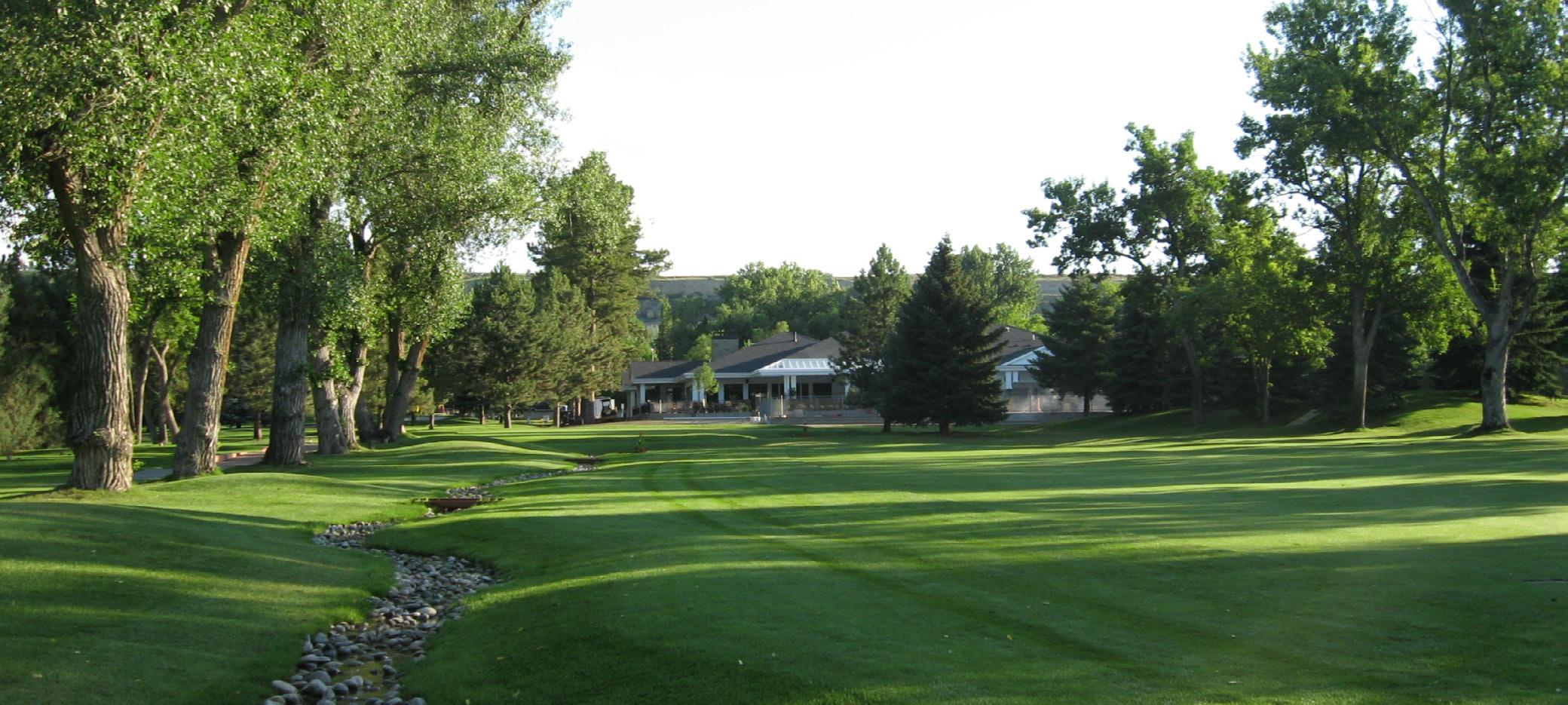









BY TY SPARING MSGA COMMUNICATIONS COORDINATOR
Tobacco Valley Invitational
April 16-17 – Indian Spring Ranch Golf Course & Wilderness Club (Eureka)
The Tobacco Valley Invitational was held April 16-17 in Eureka with four Class B girls teams and ten boys teams. Playing two rounds, competitors played the first round at the Indian Springs Ranch Golf Course and the second at the Wilderness Club. Once again it was the Munding siblings both claiming individual victories.
Fresh off a win at the Florence/Darby Invitational, Loyola’s Zach Munding took home another individual victory, winning the event by six strokes with a final score of +5 (148). Munding caught fire in the second round, recording seven birdies on his way to a tournament best round of -4 (68).
Munding was followed by Florence-Carlton’s Brody Duchien in second place at +11 (154), Lincoln County’s Conner McDole in third place at +16 (159), and the top five was rounded out by Three Forks’ Hunder Feddes in fourth with a score of +23 (166) and Aaron DeFrance in fifth at +25 (168).
Three Forks won the boys team event with a cumulative two round score of +109 (681). They claimed first by just two strokes over Florence-Carlton.
Elder sibling Elise Munding won the girls
event by just two strokes over Seeley-Swan’s Mia Nicholas. Munding got off to a six-stroke lead in the first round with a tournament best score of 82 and managed to hold onto the lead for her second win in a row at +28 (171). Nicholas meanwhile led the field with four birdies en route to a +30 (173) finish.
Following Nicholas was Florence-Carlton’s Kipley Solari in third place at +41 (184). Anaconda’s Grace Galle ended up in fourth place at +62 (205), just one stroke ahead of fifth place finisher Solveig Hygaard from Thompson Falls who finished with a score of +63 (206).
Florence-Carlton won the girls team event at +275 (847). Anaconda finished in second with a total score of +321 (893).
Seeley Swan’s Mia Nicholas put an end to Elise Munding’s winning streak at the LSH Spring Swing in Missoula. With the first round at the Ranch Club and the second at Larchmont, Nicholas and Munding came into day two tied at +10 (82) but with three pars in the final fours holes of play, Nicholas managed to gain the upper hand and finish with the individual girls victory at +22 (166). Munding meanwhile finished at +24 (168).
Florence-Carlton’s Kipley Solari finished in third place at +32 (176), Anaconda’s Logan McKay ended in fourth place at +35 (179) and Florence-Carlton’s Reese Briney rounded out the top five at +53 (197).
Florence-Carlton once again one the girls’ team event over Anaconda with a two round score of +216 (792). Anaconda finished at +250 (826).
On the boys side Zach Munding’s big sister might’ve broke her winning streak, but he won his third in a row, squeaking out a one stroke victory over Jefferson’s Tyson Lee. Munding had a first round of -3 (69) in which he hit four birdies and only one bogey and held on in the second round to win the event at +1 (145). Lee put the pressure on with a second round of -1 (71) that feature an eagle on the par-5 hole 7, along with three more birdies on the front nine (holes 2, 4, 9).
Jefferson’s Ben Werner ended up in third place at +5 (149), Eureka’s Connor McDole claimed the fourth spot at +16 (160), and

Seely-Swan’s Aiden Posthumus finished in fifth place with a final two-round score of +17 (161).
Jefferson won the boys team event at +69 (645), while Loyola finished in second place at +108 (684).
Columbus’ William Conat won the boys individual title at the single day Roundup Golf Invite. Conat won the event -1 (71) by six strokes with a round featuring an eagle on the par-5 thirteenth hole along with two birdies (holes 2, 4).
In second place was Colstrip’s Drew Batie at +5 (77), followed by a three-way tie for third

place between Batie’s teammates Dylan Wilson and Cody Bradley along with Shepherd’s Carson Gamradt who all scored +7 (79).
With three players in the top four, Colstrip won the team event at +27 (315), followed by Sweet Grass County in second at +57 (345).
On the girls’ side Roundup’s hometown golfer Hallie Hofer won the individual title at +16 (88), two strokes ahead of Park City’s Marisa Rathburn who finished at +18 (90). Third place went to Red Lodge’s Alyssa Emineth at +20 (92), while Shepherd High School landed Breanna McFate in fourth place at +21 (93) and teammate Kate O’Donnell in fifth at +22 (94).
Roundup won the girls team event at +121 (377), followed by Red Lodge in second place at +131 (419).

Ennis Invite – April 24
Madison Meadows Golf Course (Ennis)
Lone Peak’s Olivia Kamieniarz won the girls individual side of the single round Ennis Invite at Madison Meadows Golf Course. Kamieniarz’s round of +10 (82) gave her the win by thirteen strokes. She was propelled by an early eagle on the par-5 hole 6, followed by a birdie on hole 9.
In second place was Three Forks’ Kennedy Rogers who also claimed a birdie on hole 4 on her way to a score of +23 (95). Gardiner’s Fiona Roberts and Lone Peak’s Dylan Manka tied for third place at +26, while Ennis’ Marisa Snider finished in fifth place at +27 (99) on her hometown course.
Lone Peak won the girls’ team event at +125, followed by Three Forks in second at


+148 and Ennis in third at +174
Playing on his home course Ennis’ John Hostetler won by nine strokes with a final score of +3 (75). Hostetler started the round with a birdie on the first and third holes, followed by two more birdies on the back nine.
Sweet Grass teammates Sawyer Durfee and Rocky Kovatch finished in a tie for second place at +12 (84), Manhattan Christian’s Max Venhuizen took fourth place at +14 (86) and Three Forks’ Hunter Feddes finished in fifth place at +16 (88).
There was a tie for first place in the boys’ team event between Manhattan Christian and Sweet Grass County with final scores of +78. Three Forks claimed the third spot at +80.
Colstrip took home the top three boys spots during the single round Colstrip Invite at the Ponderosa Butte Golf Course. Drew Batie earned the top spot by eight strokes at +4 (76). Batie had three birdies on the round. Cody Bradley finished in second place at +12 (84), followed by fellow Dawson Batie in third at +13 (85), Shepherd’s Karson Gamradt took fourth place at +14 (86) and in a tie for fifth place was Shepherd’s Mason Gamradt and Colstrip’s Dylan Wilson at +15 (87).
With four golfers in the top five, Colstrip took home the team victory at +44 (332), followed by Shepherd at +72 (360) and Forsyth in third place at +82 (370).
There was a tie for first place in the girls division, with Shepherd’s Brenna McFate and Colstrip’s Kyla Kerzmann both claiming the top spot at +30 (102). Shepherd’s Kayda Parker finished in third at +33 (105), Forsyth’s Remi Pederson ended up in fourth place at +34 (106) and Broadus’ Laney Williams finished in fifth place with a final score of +35 (107).
Shepherd earned the team girls victory at
+178 (466) and Colstrip secured second place at +181 (469).
Absarokee/Park City Varsity Invite – April 16 – Stillwater Golf Course (Columbus)
Absarokee’s Adisyn Kennedy won the girls individual division at the Absarokee/Park City Varsity Invite at the Stillwater Golf Course in Columbus. Her score of +13 (85) was fifteen strokes ahead of second place finisher, Park City’s Marisa Rathburn who finished at +28 (100). White Sulphur Springs’ Julianna Feddes took third at +29 (101), Absarokee’s Bree Kennedy took fourth place at +33 (105) and teammate Haylie Clark took fifth at +45 (117).
Absarokee took the top two individual spots on the boys side with Jaxon Gallagher finishing in first place at +3 (75) while Tristen Phillips finished second at +6 (78). White Sulphur Springs’ Jason Kerr finished in third at +21 (93), Park City’s Rocky Gwin took fourth at +22 (94), and Brody Paternostro of Absarokee took fifth place at +25 (97).
Fairview Invite – April 22
Sidney Country Club (Sidney)
Huntley’s Griffen Zimmer took first place in the boys division at the Fairview Invite on April 22. His single round of +8 (80) was three strokes ahead of Scobey’s Cooper Axtman at +11 (83). In third place was Huntley’s Baylor Burton at +14 (86), fourth place went to Plentywood’s Carson Solberg at +16 (88), and fifth went to Baker’s Griffith Chad at +17 (89).
Huntley won the boys team event at +73, followed by Scobey at +82 and Baker in third place at +86.
Lambert’s Emma Biernaux won the girls event by twelve strokes at +17 (89). She had two birdies on the round (holes 7, 16). Scobey’s Ashtynn Fladager finished in second place at +29 (101), Glasgow’s Laynee Simpson
took third at +31 (103), Plentywood’s Sidney Richardson finished in fourth at +33 (105), and Scobey teammates Clair Lekvold and Avery Wolf tied for fifth place at +34 (106).
Plentywood won the team girls event at +122, followed by Scobey in second at +144, and Huntley and Glasgow tied for third at +149.
Sidney Country Club (Sidney)
Lambert’s Emma Biernaux won for the second event in a row at the RnL Fusion at the Sidney Country Club. Her single round of +18 (90) was one stroke ahead of Savage’s Aspen Peterson who finished at +19 (91). Peterson’s teammates Taylor Condradson and Emma McPherson finished in third and fourth at +26 (98) and +28 (100) respectively. Annika Sorenson out of Forsyth finished in fifth place at +30 (102).
Savage won the girls team event with a total score of +73 (289), followed by Scobey in second at +99 (315) and Plentywood in third place at +103 (319).
On the boys side Huntley Project’s Baylor Burton finished in first place at +5 (77) while teammate Griffin Zimmer tied Scobey’s Cooper Axtman for second place at +6 (78). Froid-

Lake’s Carsen Kelm ended up in fourth at +12 (84), while Plentywood’s Aydan Kaul and Scobey’s Brecken Maher tied for fifth place at +13 (85).
Huntley Project won the boys team event at +27 (243), followed by Scobey in second at +38 (254) and Forsyth in third place with a final score of +62 (278).
Centerville produced the top two boys spots at the Choteau Class C Invite, with Grady Dow snagging first with a final single round score of +9 (80), while Jase Troyer tied for second at +13 (84) with Fort Benton’s Spencer. Molinario’s teammate Ethan Olson tied for fourth place with Centerville’s Kale Annis at +15 (86).
With three golfers in the top five, Centerville took home the boys team victory at +37 for the day. Fort Benton finished in second at +46, while Great Falls Central Catholic finished in third at +51.
Centerville’s Maddi Adams won the individual girls event with a single round score of +17 (89). She was followed by Fort Benton’s Addison Reichelt in second place at +21 (93) and teammate MyCal Lane in third place at +22 (94).

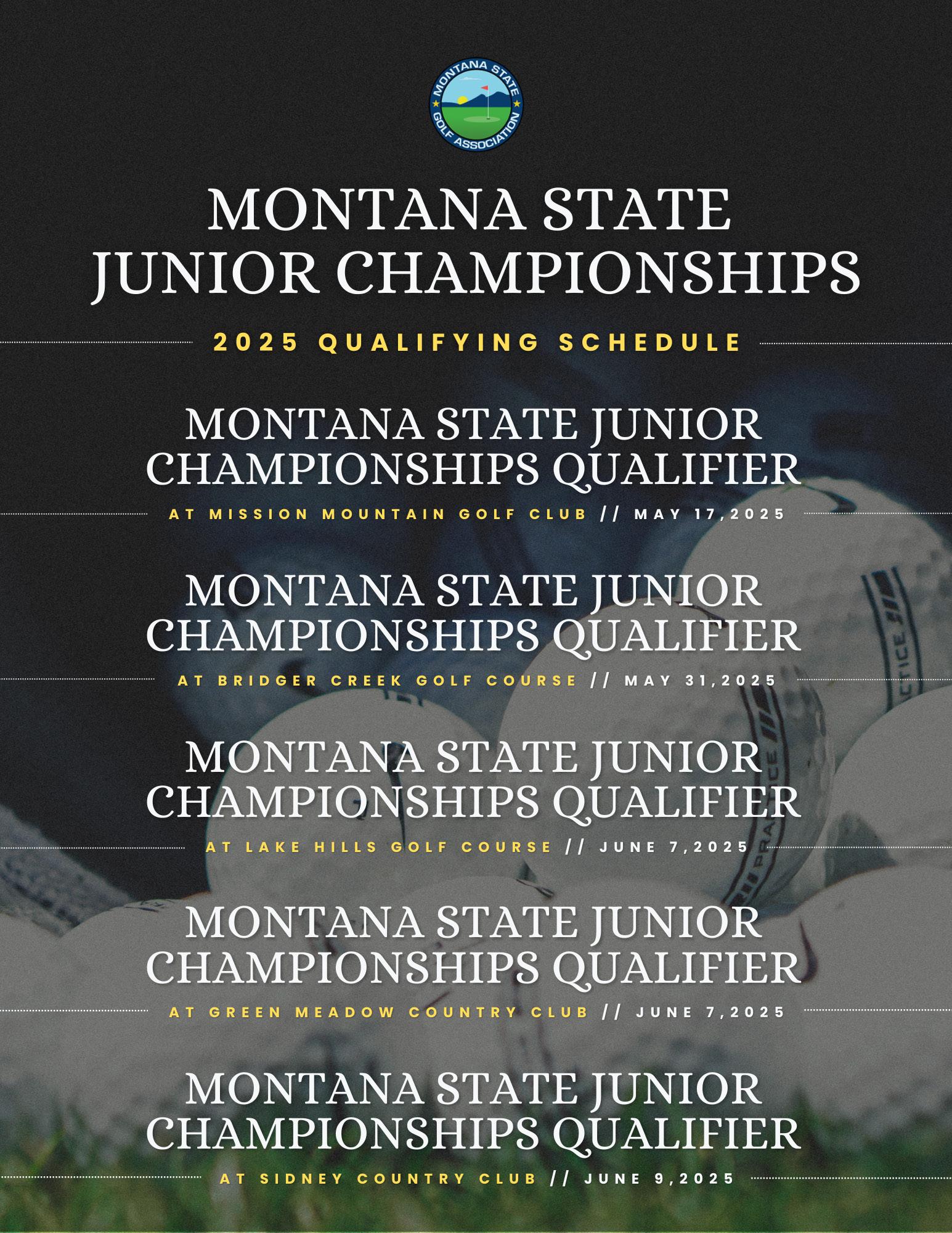
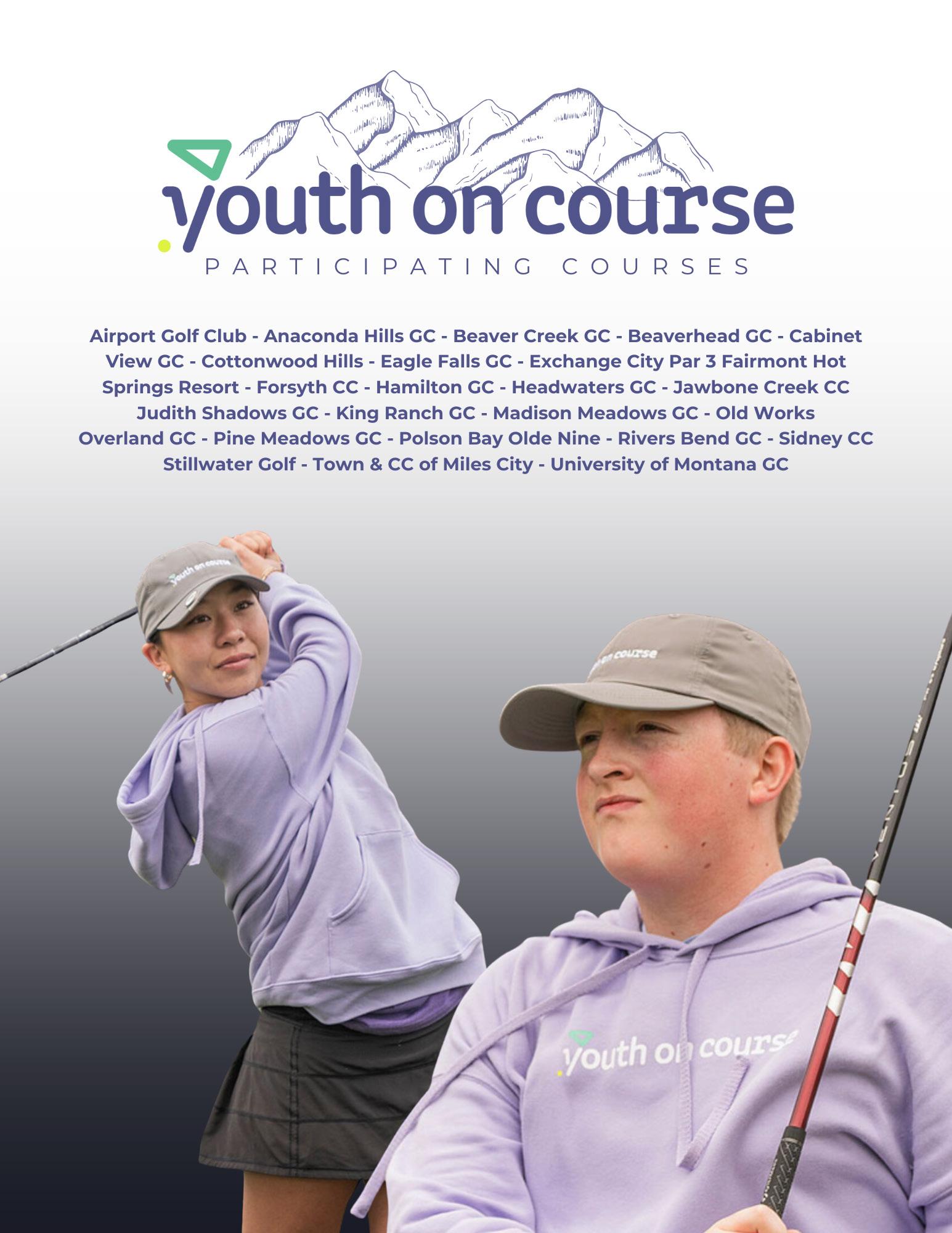


BY TY SPARING
Montana State University and the University of Montana capped off their seasons recently at the Big Sky Conference Women’s Golf Championships. Held April 14-16 at the Wigwam Resort in Litchfield, Arizona, the event had plenty of thrills including the notable performance of MSU’s Maddie Montoya who was near flawless all three rounds en route

to the Bobcat’s third individual title in program history.
It was an auspicious first round for Montana golfers as both teams got off to exceptional starts, with MSU sitting in second and UM in third going into the second day, along with a host of individuals scattered throughout the top twenty. Montoya, who had never previously finished in the top ten of a collegiate tournament before, found herself in a tie for fourth place with Griz golfer Raina Ports after posting first round scores of -1 (70). For Ports the one under was the second-best individual round in UM history, while Montoya would go on to be

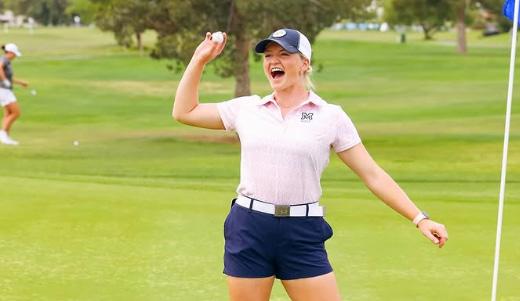
Sports Information

the only golfer in the field to record all three rounds under par.
Along with the fantastic play across the board for the Montana teams, round one had an extra bit of excitement as MSU’s Becca Tschetter recorded a hole in one on a par-4. Yes, you read that right. On the 294-yard hole fourteen she blasted a drive which sent the ball to the front of the green where it rolled approximately thirty feet to the bottom of the cup. Even crazier is the fact that it’s the second hole in one for Tschetter during tournament play this month.
Round two saw a bit of evening out amongst the field but the Griz and Bobcats were still hanging tough overall. For Montoya, after a first round with four birdies, in round two she collected three more birdies and an eagle from 130 yards out on the par-4 hole seven. Having not recorded a round under par all season, it was good timing for Montoya to pull it off in back-to-back days. The only issue was that she needed to do it one more time on day
three in order to come out victorious.
Heading into the third day Montoya was sitting in second place, just one stroke back of Sacramento State’s senior Caitlin Maurice who was the Big Sky Conference champion in 2023. Perhaps an even scarier thought was the fact that teammate Lauren Greeny was just one stroke back in third place. Greeny has made a habit of high-pressure comebacks with three individual titles this season in which she has had to make up three or more strokes during the final day to achieve victory.
As part of a team that has been smashing records these past three years, it should come as no real surprise that Montoya had the potential to become the Big Sky Conference Champion. Last year in fact she ended the season with the eighth best single season scoring average in school history, and this past November she and Scarlet Weidig qualified for the U.S. Women’s Amateur Four-Ball Championship. But in the wake of three Bobcats making All-Conference this year for the first time in

program history (Greeny 1st team, Tschetter 2nd team, Weidig Honorable Mention), it’s understandable if Montoya went a little under the radar in a program as deep as Montana State.
On day three Montoya and Greeny both continued to play exceptional golf and with just a few holes left, both had a great shot at winning the individual title. Montoya was trailing by three strokes after the first ten holes, but after a couple bogeys by Sacramento State’s Maurice, by hole fourteen there was a three-way tie between her and the two Bobcat teammates.
After a birdie on fourteen and making a huge 25-foot putt on hole fifteen, Montoya all the sudden found herself in first place by two strokes, and on the verge of history. Maurice
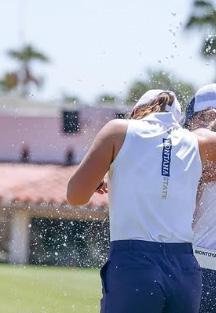
carded a birdie on hole seventeen, so going into the final hole Montoya was holding onto a precious one stroke lead, with nothing but pressure to accompany her.
After an outstanding second shot on the par-5 eighteenth hole put Montoya on the green, a two-putt for birdie was the only thing separating her from achieving Big Sky Conference glory. Keeping her composure, Montoya did just that, carding a title-clinching birdie followed by a jubilant water dousing celebration put on by her teammates. In victory Montoya became just the third golfer in MSU history to win the Big Sky Conference crown, joining program legends Jen McGregor (1995) and Paige Crawford (2013) as Bobcat champions.
Following Montoya for MSU was the reigning two-time Montana State Women’s Ama-
teur Champion Lauren Greeny, who ended up in a tie for fourth place with an even par 213. Also in the top twenty was the reigning twotime Montana State Match Play Champion, Scarlet Weidig, who finished up in a tie for 16th place at +8 (221). For the senior Weidig, she has played in her last event as an MSU Bobcat, having secured her place as one of the best golfers in the history of the program.
As a team Montana State finished in third place +17 (869), just one stroke back from Weber State who caught fire on the third day and put up the lowest cumulative round of the tournament.
The University of Montana meanwhile

finished in seventh place as a team at +43 (895). With a goal of finishing in the top five, the youthful Griz were battling for that fifth spot until the very end with some impressive performances individually.
Four UM players landed in the top half of the field, with junior Raina Ports leading the way in a tie for fourteenth place at +7 (220) overall. Ports was followed by Elle Higgins who finished the three rounds in a tie for 21st place. The sophomore Higgins continued to prove her ability to compete against anybody in the conference after the first two rounds saw her at +1 (71-72) and in a tie for seventh place going into the final day. A tough third

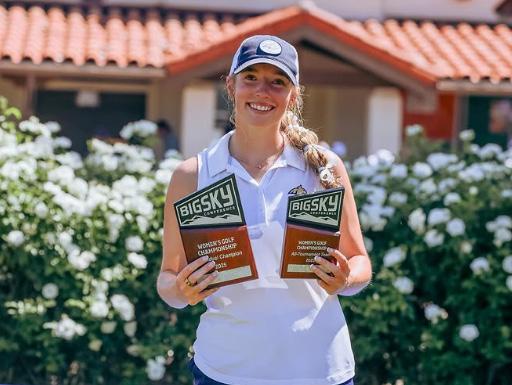
Instagram/ @ MSUBobcatsGolf
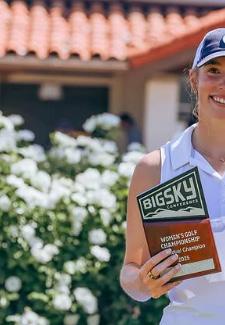
round saw her drop a few spots, but for a young Griz team Higgins performance shows just how much potential they have on the roster.
In a tie for 24th place at +12 (225) was the UM sophomore Kate Bogenschutz. Competing in her first Big Sky Conference Championship, Bogenschutz led the team with nine birdies over the three rounds as she closed out her season on a high note after several weeks of playing consistent high-level golf.
Finally, in 27th place was freshman Bella Johnson who shot up ten spots in the final day to finish at +13 (226) overall. Her third round of 71 was the fifth best in the field and gave Griz fans yet one more reason to get excited for the coming years.
Winning the team event by fifteen strokes was Sacramento State at +1 (853). That’s three in a row now for the Hornets who join just two other programs to win three straight Big Sky Conference Women’s Golf Championships.
Congratulations to Maddie Montoya on her exciting victory! Next up Montoya will be representing the Bobcats May 5-7 at the NCAA Regionals, and after that she’ll be in her hometown of Boise this summer working as a Boatwright Intern for the Idaho Golf Association.
To view Montoya’s title clinching putt, CLICK HERE
For full results of the Big Sky Conference Championships, CLICK HERE
The men’s and women’s Frontier Conference Championships were held April 14-16 at the Papago Golf Club in Phoenix, Ariz. Once again, the Frontier Conference arranged one joint championship with the California Pacific Conference, which enabled teams to qualify for the NAIA National Championships in late May. No worries either way for the Rocky Mountain golf program as both the men’s and women’s teams have been in juggernaut status for some time now, and once again swept both the team and individual events.
In a field of eight teams on the men’s side the Battlin’ Bears established an early 21 stroke team lead after round one. When the tournament was over they were still in first place at -1 (863), and still 21 strokes ahead of the second-place finishing team, Simpson Uni-

versity. That makes it now seven conference championships over the last eight years for the Rocky men’s team, and once again they’ve earned a birth to the NAIA National Championships in Illinois.
Montana Tech finished in third place at +25 (889), Carroll College ended up in fourth at +79 (943), and MSU-Northern rounded out the Frontier Conference with an eighth-place finish at +245 (1109).
Rocky was led by four golfers in the top ten, including the medalist recipient Kristjan Burkelca. Burkelca, a Slovenian who transferred over from UTEP this past fall finished off a fantastic first season with RMC by getting off to an early lead and eventually winning the three-round event by six strokes. His impressive final round of 69 saw three birdies recorded and fifteen pars hit.


Following Burkelca was teammate Jake Johnson who finished in a tie for second place at -1 (215). Johnson shot up the leaderboard by a few spots in the final round after also registering a three-under 69.
Along with Burkelca and Johnson in the top ten, Aidan McDonagh finished in fourth place at +1 (217), while Jared Smith tied for eighth place at +6 (222).
Montana Tech had battled with Simpson over second place throughout the Conference Championship, and although they ended up in third place at +25 (889), they had some impressive individual performances as well. Joe McGreevey led the Orediggers with a fifthplace finish at +2 (218). McGreevey vaulted up

the leaderboard with a final round of -3 (69) notable for a blistering final nine holes that saw the Helena native hit four birdies and an eagle, along with four pars.
Following McGreevey for Montana Tech was Carson Hupka who finished in sixth place at +3 (219), Tyler Avery in eleventh place at +11 (227) and Joe Opitz ended up in a tie for thirteenth place at +14 (230).
Outside of RMC and Montana Tech, Carroll College freshman Kyle Kennah was the last remaining Frontier Conference golfer in the top fifteen, finishing up the three rounds at +13 (229).
On the women’s side it was yet another
clean sweep for Rocky Mountain, although the Montana Tech team kept them on their toes throughout the tournament. The Battlin’ Bears recorded a tournament best team score of 314 on the first day, which was enough cushion to hold off an Oredigger team that went on to post better scores than RMC in rounds two and three. Ultimately Rocky won the event for the fourth year in a row by nine strokes at +104 (968). Like the men’s team, the lady Battlin’ Bears will show up ready to compete with the best of the best at the NAIA National Championships later in May.
Carroll College, the only other Frontier

Conference team represented in the field of six teams finished in third place at +183 (1047).
Winning the individual event was Grace Metcalf, who managed to fend off teammate Isabella Downing for a wire-to-wire conference title victory. The junior from Washington had a stellar first round of +2 (74) in which she recorded one birdie and just three bogeys. Despite a late run from Downing, Metcalf managed to hold onto the lead throughout the tournament and ended up winning by two strokes at +18 (234) overall. Downing meanwhile recorded nine birdies over the three

Mark Robertson / MT Tech Athletics
rounds on her way to a second-place finish at +20 (236).
Also in the top fifteen for RMC was Kadence Fischer who ended up in seventh place at +32 (248), Tyla Potgieter in ninth place at +35 (251), and Alivia Webinger who tied for thirteenth place with a final score of +39 (255).
Montana Tech also littered the top fifteen with Oredigger golfers, led by Kodie Hoagland and Emma Woods who tied each other for third place at +26 (242). Casha Corder ended up in eighth place at +33 (249), Franchi Ceartin placed in a tie for tenth place at +36 (252), and Samantha Benson finished up in twelfth place at +38 (254).
Carroll College also placed a few players in the top fifteen with Ellie Stastny leading the
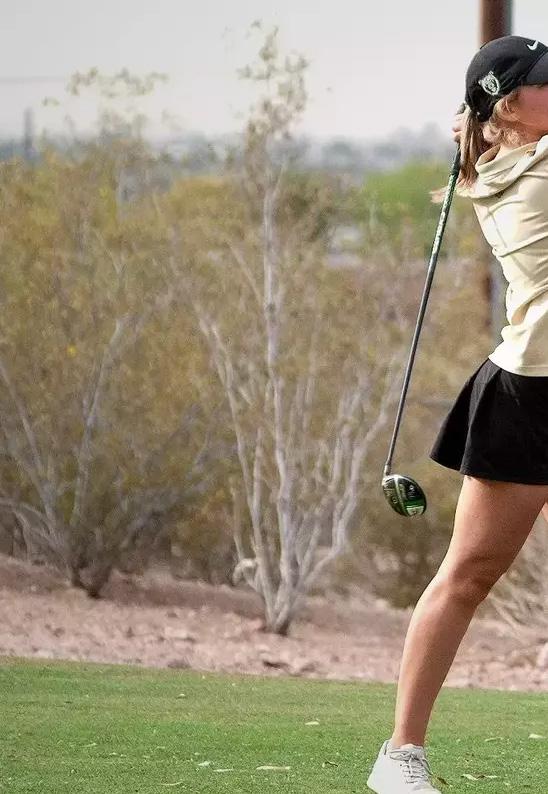
way with a sixth-place finish. The freshman out of Murtaugh, Idaho carded the lowest round of the tournament on day three with a +1 (73). It is also believed to be the lowest single round performance during conference championships in program history.
Stastny’s twin sister Alli tied for thirteenth place at +39 (254), while Stella Claridge placed fifteenth at +44 (260).
Congratulations to all the Frontier Conference golfers on another successful season! We are excited for what’s to come next year as the Frontier Conference will bring in several other schools into the fold.
For full results of the Frontier Conference Championships, CLICK HERE


MSU-Billings Men and Women at the GNAC Championships
The MSU-B men’s and women’s golf teams wrapped up their season recently at the Great Northwest Athletic Conference Golf Championships. Held April 21-22 at the Coeur d’Alene Resort Golf Course, the men’s teams had three rounds of play while the women had two.
After an injury plagued season last year, the women’s team rebounded this year with some fantastic performances culminating with a third place finish out of six teams with a final score of +51 (627). Orraya Tipasathien once again led the Yellowjackets, landing in a tie for sixth place at +8 (152). For Tipasathien the GNAC Championship concluded a season in which she broke many program records and at one point had won five tournaments in a row.
Joining Tipasathien in the top ten was Ella Tannenberger in ninth place at +10 (154) and Pygmy Kompoj who tied for tenth place with a
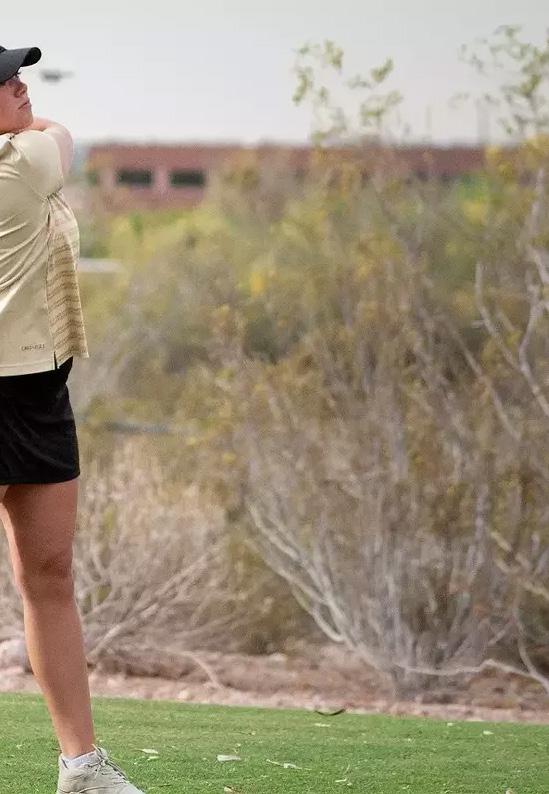
final two round score of +12 (156).
Simon Fraser University won the women’s team event at +31 (607), while also producing the individual titlist in Meera Minhas who won by one stroke at +3 (147).
For full women’s results of the GNAC Championships, CLICK HERE
The men’s team didn’t fare quite as well as the women’s as they finished in fifth place with a cumulative score of +91 (943). Hayato Ito was the lone Yellowjacket in the top twenty this year with a sixteenth-place finish at +14 (227).
Simon Fraser also won the men’s team event with a total three-round score of -4 (859). Northwest Nazarene’s Ben Mulder dominated the individual side of things, winning the title by six strokes at -6 (207).
For full men’s results of the GNAC Championships, CLICK HERE
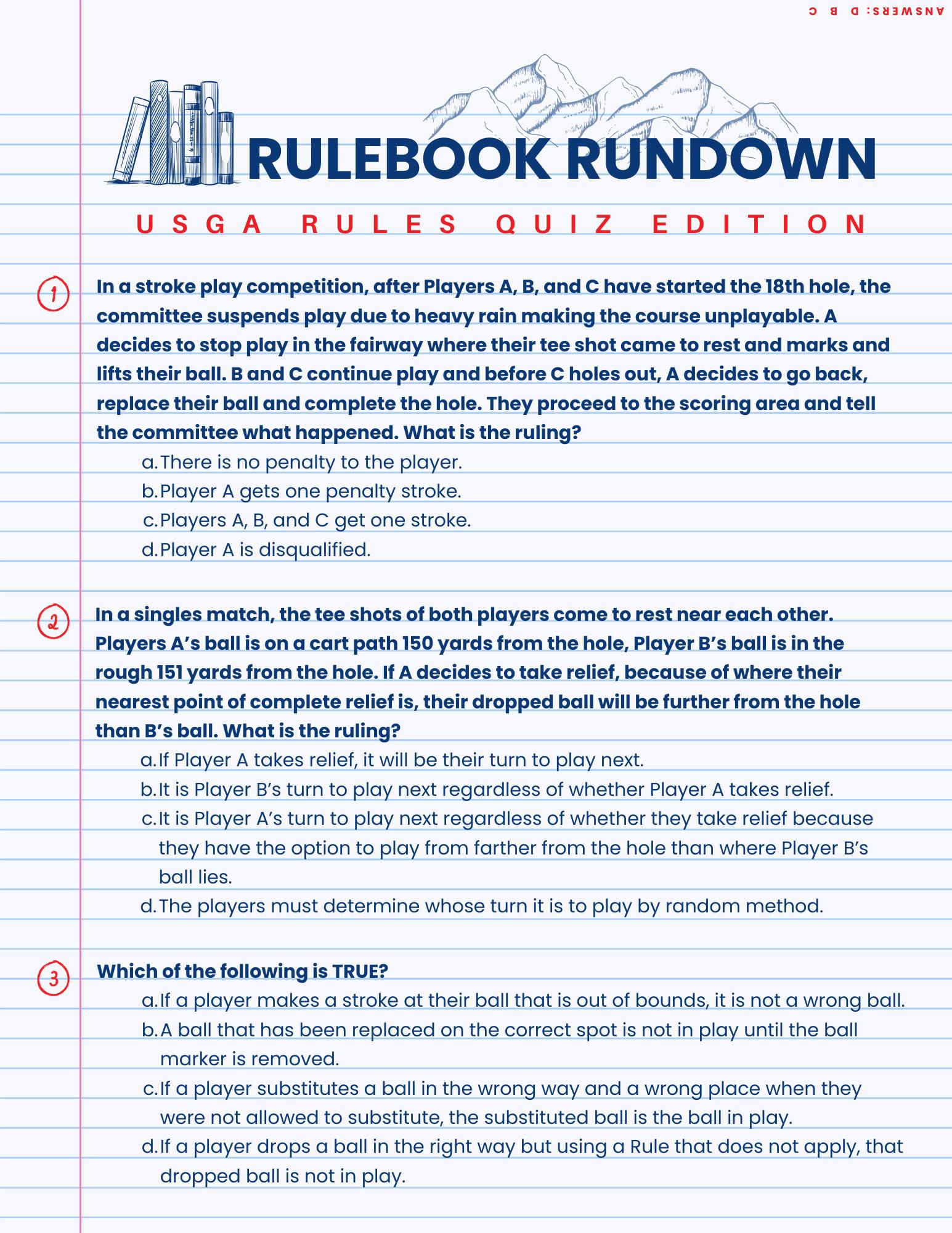




BY ZACH NICOLUDIS REGIONAL DIRECTOR, CENTRAL REGION
f you asked a group of golfers who played a certain course on a certain day about the condition of the greens, you might get some surprisingly different answers – especially among those who played early in the day and those who played later. Why is that? Sure, how well (or poorly) someone putted during the round in question influences their opinion, but putting green conditions really do change throughout the day – and there are many reasons why.
The turf on putting surfaces is a living organism and it is growing all day long. This plays a role in how conditions change. Golf course superintendents try to keep greens growing enough to recover from all the traffic and stress they experience while at the same time avoiding excessive growth that can lead to a significant drop in speed during the day. Nevertheless, greens that are growing will inevitably get a little slower as the day goes on.
Research shows that the average golfer cannot reliably detect a difference in putting green speed less than 6 inches on the Stimpmeter. Therefore, if speeds do not drop more than 6 inches throughout the day, golfers who play later probably wouldn’t notice the change in speed from morning to afternoon. Maintaining speeds that don’t change much throughout the day is achievable under favorable weather conditions but Mother Nature does not always cooperate.
Moisture in the form of humidity or rain-
fall impacts how putting greens perform. The “sticky” putting conditions experienced when humidity is high result from leaf blades retaining moisture and becoming fat. There is no maintenance practice that can be performed to overcome these conditions. If the forecast indicates high humidity, bring your heavy putter because the greens will likely feel softer and stickier throughout the day.
Rain during the day also has a significant impact on putting green conditions, especially firmness and speed. Given the frequency of pop-up afternoon storms throughout the summer in many regions, it is very possible that morning groups might miss the rain while those playing in the afternoon find themselves dealing with very different conditions. Should a midday rain event occur, putting greens will obviously be slower and more receptive in the afternoon and there isn’t anything the maintenance team can really do about it. However, greens that are built with good drainage will handle rain better and experience less of an impact from normal rain events.
Foot traffic, especially when putting greens are softer, will impact smoothness and trueness. Each step taken creates a subtle inconsistency in the putting surface and as more rounds are played throughout the day, putting greens will be less true and less smooth. This is especially true on greens with an excessive amount of thatch because this layer of organic matter can make the surface soft and spongy. One key reason why superintendents perform aeration and topdressing is to keep putting surfaces firmer and more resistant to foot-


prints by removing and diluting the thatch layer with sand.
In addition to the number of rounds played, how foot traffic impacts putting green conditions depends on shoe selection and how golfers walk. USGA-funded research shows that rubber, spikeless shoes disrupt putting surfaces the least while flat outsoles with cleats are the most disruptive. If the spikes on your golf shoes look like they’d be a good choice for an NFL lineman, try to tread lightly! And regardless of shoe selection, walking irresponsibly on putting greens will negatively impact ball

roll. Do not drag your feet, and avoid twisting while standing or walking. If you do accidentally leave a scuff, try to tamp it down with your putter; and if you really want to do your fellow golfers a solid, choose golf shoes with less-aggressive soles.
No matter the maintenance budget, putting green conditions change throughout the day at every course. Golf course superintendents tailor their programs to keep conditions as consistent as possible, but growing grass, changing weather and thousands of footsteps are going to have an impact.


